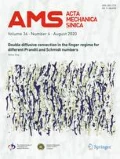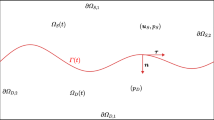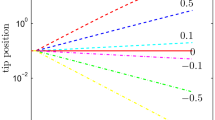Abstract
To investigate tumor-induced angiogenesis under the influence of the mechanical environments inside and outside the tumor, mathematical model of tumor angiogenesis was developed. In the model, extra-cellular matrix (ECM) was treated as a thin plane. The displacement of ECM is obtained from the force balance equation consisted of the ECs traction, the ECM visco-elastic forces and the external forces. Simulation results show that a layered capillary network is obtained with a well vascularized region at the periphery of the tumor. The present model can be used as a valid theoretical method in the basic researches in tumor-induced angiogenesis.
Similar content being viewed by others
References
Folkman J.: Therapeutic implication. N. Engl. J. Med. 285, 1182–1186 (1971)
Helmlinger G., Netti P.A., Lichtenbeld H.D. et al.: Solid stress inhibits the growth of multicellular tumor spheroids. Nat. Biotechnol. 15, 778–783 (1997)
Araujo R.P., McElwain D.L.S.: The role of mechanical host-tumor interactions in the collapse of tumor blood vessels and tumor growth dynamics. J. Theor. Biol. 238, 817–827 (2006)
Nikos V.M., Steve W., Hans G.O.: Mathematical modeling of tumor-induced angiogenesis. J. Math. Biol. 49, 111–187 (2004)
Anderson A.R.A., Chaplain M.A.J.: Continuous and discrete mathematical models of tumor-induced angiogenesis. Bull. Math. Biol. 60, 857–900 (1998)
McDougall S.R., Anderson A.R.A., Chaplain M.A.J.: Mathematical modelling of flow through vascular networks Implications for tumour-induced angiogenesis and chemotherapy strategies. Bull. Math. Biol. 64, 673–702 (2002)
Holmes M.J., Sleeman B.D.: A mathematical model of tumour angiogenesis incorporating cellular traction and viscoelastic effects. J. Theor. Biol. 202, 95–112 (2000)
Gao H., Xu S.H., Cai Y. et al.: Numerical simulation of tumor-induced angiogenesis incorporating mechanical effect. J. Med. Biomech. 21, 2–7 (2006) (in Chinese)
Baxter L.T., Jain R.K.: Transport of fluid and macromolecules in tumors I. Role of interstitial pressure and convection. Microvasc. Res. 37, 77–104 (1989)
Murray J.D., Oster G.F.: Cell traction models for generation of pattern and form in morphogenesis. J. Math. Biol. 19, 265–279 (1984)
Murray J.D.: Mathematical Biology. Springer, New York (2003)
Jain R.K.: Transport of molecules, particles, and cells in solid tumors. Annu. Rev. Biomed. Eng. 10, 241–263 (1999)
Landau L.D., Lifshitz M.: Theory of Elasticity. Pergamon, London (1959)
Chaplain M.A.J., Stuart A.M.: A model mechanism for the chemotactic response of endothelial cells to tumour angiogenesis factors. IMA J. Math. Appl. Med. Biol. 10, 149–168 (1993)
Chaplain M.A.J., Anderson A.R.A.: Mathematical modeling, simulation and prediction of tumour induced angiogenesis. Invasion and Metastasis 16, 222–234 (1996)
Orme M.E., Chaplain M.A.J.: Two-dimensional models of tumour angiogenesis and anti-angiogenesis strategies. IMA J. Math. Appl. Med. Biol. 14, 189–205 (1997)
Duda D.G., Sunamura M., Lozonschi L. et al.: Overexpression of the p53-inducible brain-specific angiogenesis inhibitor 1 suppresses efficiently tumour angiogenesis. Br. J. Cancer 86, 490–496 (2002)
Weidner N.: Intratumor microvessel density as a prognostic factor in cancer. Am. J. Pathol. 147, 9–19 (1995)
Manoussaki D., Lubkin S.R., Vernon R.B. et al.: A mechanical model for the formation of vascular networks in vitro. Acta Biotheoret. 44, 271–282 (1996)
Risau W.: Mechanisms of angiogenesis. Nature 386, 671–674 (1997)
Zhao G.P., Wu J., Xu SX. et al.: Numerical simulation of blood flow and interstitial fluid pressure in solid tumor microcirculation based on tumor-induced angiogenesis. Acta Mech. Sin. 23, 477–483 (2007)
Wu J., Xu S.X., Long Q. et al.: Coupled modeling of blood perfusion intravascular, interstitial spaces in tumor microvasculature. J. Biomech. 41, 996–1004 (2008)
Author information
Authors and Affiliations
Corresponding author
Additional information
The project was supported by the National Natural Science Foundation of China (10372026 and 10772751), Shanghai Leading Academic Discipline Project (B112).
Rights and permissions
About this article
Cite this article
Cai, Y., Gulnar, K., Zhang, H. et al. Numerical simulation of tumor-induced angiogenesis influenced by the extra-cellular matrix mechanical environment. Acta Mech Sin 25, 889–895 (2009). https://doi.org/10.1007/s10409-009-0301-3
Received:
Revised:
Accepted:
Published:
Issue Date:
DOI: https://doi.org/10.1007/s10409-009-0301-3




